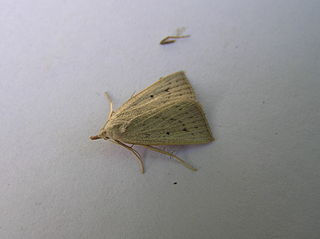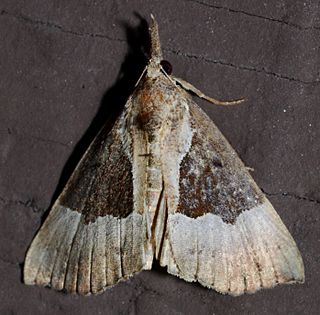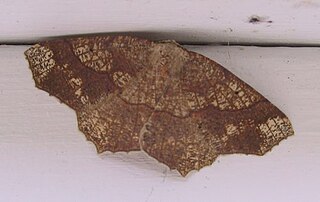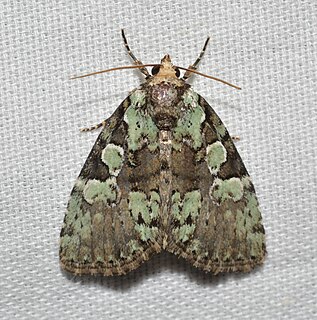
Schinia, commonly called flower moths, is a large genus of moths belonging to the family Noctuidae. The genus has a Holarctic distribution with the vast majority of species being found in North America, many with a very restricted range and larval food plant.

Macrochilo is a genus of litter moths of the family Erebidae. The genus was erected by Jacob Hübner in 1825.
Autographa bimaculata, the two-spotted looper moth, twin gold spot or double-spotted spangle, is a moth of the family Noctuidae. The species was first described by James Francis Stephens in 1830. It is found in North America from Newfoundland west, just short of the coast of British Columbia, north to the Northwest Territories and south to New Mexico in the west and Pennsylvania and Long Island in the east.

Autographa sansoni, the Alberta beauty, is a moth of the family Noctuidae. The species was first described by F. H. Wolley Dod in 1910. It is found in the western mountains of North America, from Alaska south to Oregon, Idaho and Arizona. Occurring mainly in the Pacific Northwest, it thrives in mid-to-high elevation conifer forest habitat, as well as some areas of coastal rain forest in the Coast range. However, it is also found in a non-contiguous range in sub-alpine forest in the Rocky Mountains, ranging from Alberta in the north, to New Mexico in the south. The wingspan of an adult ranges between 34 and 36 mm. It is widespread, and a relatively common species.

Hypena bijugalis, the dimorphic bomolocha, dimorphic hypena or toothed snout-moth, is a moth of the family Erebidae. The species was first described by Francis Walker in 1859. It is found in North America from Nova Scotia across southern Canada to Vancouver Island, south over the whole United States to Florida.

Euxoa catenula is a species of moth of the family Noctuidae first described by Augustus Radcliffe Grote in 1879. It is found in North America from southern Saskatchewan west to southern Vancouver Island, south to Kansas, New Mexico, Arizona and southern California.

Schinia jaguarina, the jaguar flower moth, is a moth of the family Noctuidae. The species was first described by Achille Guenée in 1852. It is found on North America's Great Plains from Saskatchewan and Alberta south to Texas, eastward on coast to Florida and westward in south to Arizona. In Mexico it is found down to Mexico City.

Schinia nuchalis, the spotted sage moth, is a moth of the family Noctuidae. The species was first described by Augustus Radcliffe Grote in 1878. It is found from the Great Plains and Great Basin, from southern Saskatchewan, Alberta and British Columbia south to northern Arizona. The Eurasian Schinia scutosa is no longer considered a synonym of Schinia nuchalis.

Macrochilo orciferalis, the chocolate fan-foot or bronzy macrochilo, is a litter moth of the family Erebidae. The species was first described by Francis Walker in 1859. It is found in North America from Wisconsin to Nova Scotia, south to Florida and Texas.
Macrochilo bivittata, the two-striped snout-moth, is a litter moth of the family Erebidae. The species was first described by Augustus Radcliffe Grote in 1877. It is found from the Atlantic coast west across the parklands and southern boreal forest of North America to central Alberta, south to Massachusetts and Ohio.

Plagodis alcoolaria, the hollow-spotted plagodis, is a moth of the family Geometridae. The species was first described by Achille Guenée in 1857. It is found in eastern and central North America.

Oligocentria semirufescens, the red-washed prominent moth or rusty prominent, is a moth of the family Notodontidae. The species was first described by Francis Walker in 1865. It is found in North America from Nova Scotia west to Vancouver Island, south to Florida, Colorado and central California.

Scopula cacuminaria, the frosted tan wave, is a moth of the family Geometridae. The species was first described by Herbert Knowles Morrison in 1874. It is found in North America across southern Canada, from the Maritimes to southern British Columbia, south to Texas.

Besma quercivoraria, the oak besma, is a moth of the family Geometridae. The species was first described by Achille Guenée in 1857. It is found across southern Canada and all of the United States except California.

Erannis tiliaria, the linden looper, also known under the rather ambiguous name "winter moth", is a moth of the family Geometridae. The species was first described by Thaddeus William Harris in 1841. It is found in North America from central Alberta east to Nova Scotia, south to Missouri, Georgia, Utah and Texas.

Melanolophia imitata, the western carpet or green-striped forest looper, is a moth of the family Geometridae. The species was first described by Francis Walker in 1860. It is found in western North America from southern California, north to Alaska and east to extreme south-western Alberta.

Ponometia semiflava, the half-yellow or yellow-cloaked midget, is a moth of the family Noctuidae. The species was first described by Achille Guenée in 1852. It is found in North America from New York and New England to Florida, west to Arizona, north to British Columbia and Manitoba.

Xanthorhoe abrasaria is a moth of the family Geometridae first described by Gottlieb August Wilhelm Herrich-Schäffer in 1856. It is found in the northern part of the Palearctic realm and the Nearctic realm.

Macaria aemulataria, the common angle moth, is a moth in the family Geometridae. The species was first described by Francis Walker in 1861. It is found from Nova Scotia to Florida, west to Texas, north to Oregon and Alberta.

Leuconycta lepidula, the marbled-green leuconycta moth, marbled-green jaspidia or dark leuconycta, is a moth of the family Noctuidae. The species was first described by Augustus Radcliffe Grote in 1874. It is found in North America from Nova Scotia to North Carolina, west to Texas and north to Alberta.
















